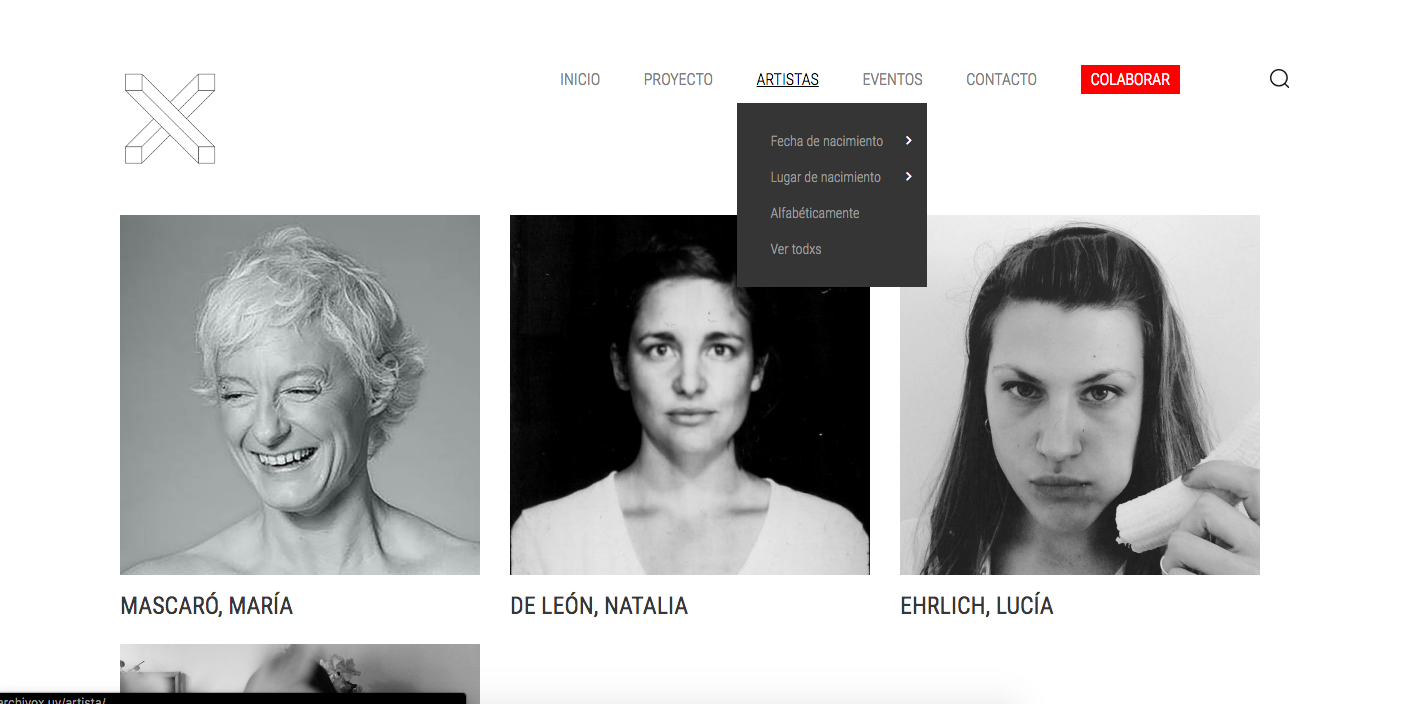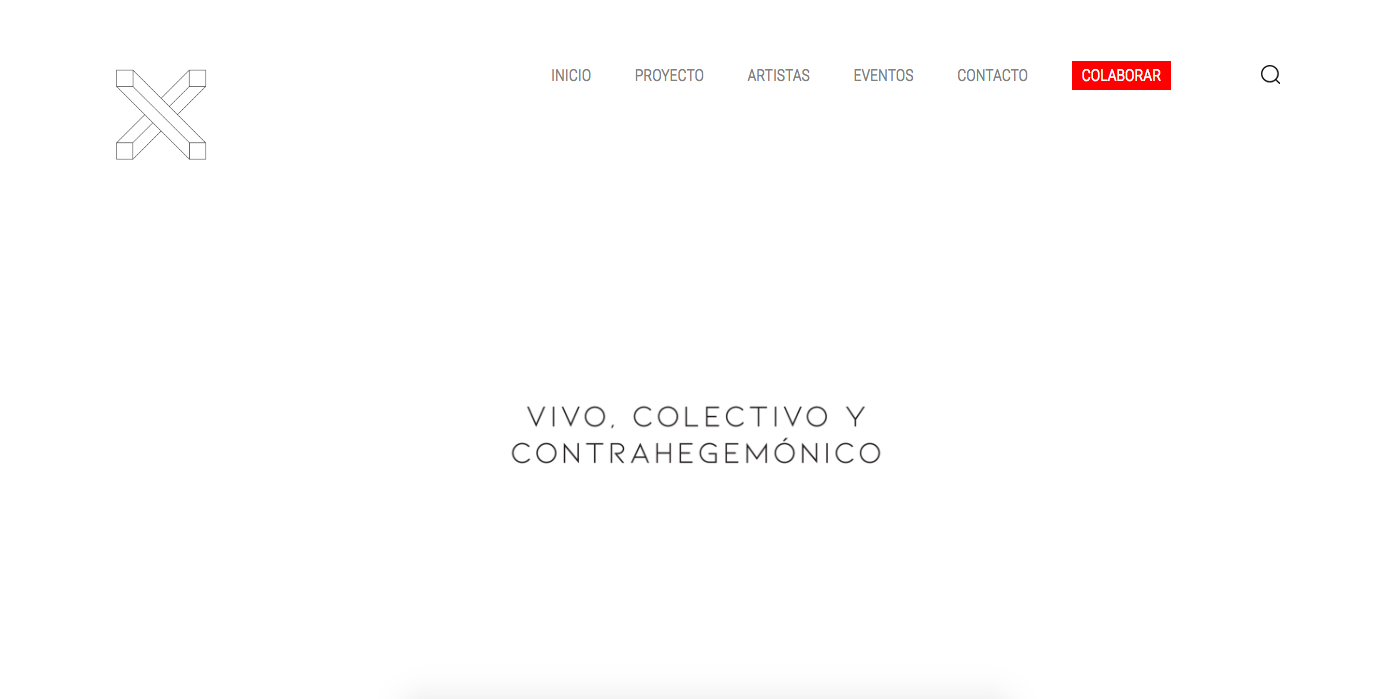ARCHIVO X
[ESP]
Resumen
Archivo X, es una acción-investigación en permanente construcción y transformación que evidencia los mecanismos violentos (misoginia, homofobia, clasismo, transfobia, racismo, etc,) en la construcción del relato hegemónico del arte en nuestro territorio y los problematiza:
¿Qué sucede cuando destruimos las bases que sostienen un relato que sustenta la historización de un territorio? ¿Es posible deshacer la historia para ocupar su lugar con múltiples relatos que puedan no resultar en una identidad única y concreta de un territorio? ¿Estamos libres de reproducir estos mecanismos en la creación de una nueva acción -archivo? ¿Es posible la construcción colectiva y en primera persona de un archivo?
Este proyecto es una respuesta independiente y autogestionada ante el problema de tantas ausencias- violencias en la historización de la cultura en Uruguay. La construcción misma del archivo activa nuevas líneas de investigación subjetivas (como una ausencia deliberada de criterios estrictos de selección), promoviendo la búsqueda constante de nuevos lugares de deconstrucción que permitan la deshegemonización en un archivo vivo, colectivo y colaborativo.
Con carácter político, cultural, educativo y social, Archivo X tiene el objetivo de recuperar y valorar a lxs artistas uruguayxs que no pertenecen al relato hegemónico, y se inscribe en el marco de las luchas feministas, transfeministas y decoloniales actuales.
Cuenta con el apoyo del Fondo Concursable de MEC.
www.archivox.uy
Fundamentación
Somos mujeres artistas del sur, herederas de la ausencia del relato de La Historia del Arte. Archivo X pretende contribuir a la deconstrucción de la hegemonía desde la creación de un archivo propio, un archivo posible, que si bien permanece abierto y permeable, jamás se establece como único y total.
Existimos en un presente de vacío informativo referente a las mujeres y otras identidades disidentes en la historia del arte nacional, que minimiza y empobrece nuestra herencia cultural. La propia construcción del Museo Nacional de Artes Visuales (MNAV) revela la desigualdad. Creado en 1911 a partir de un acervo enteramente masculino proveniente del ex Museo Nacional, recién en 1932 ingresa la obra de una artista argentina, y cinco años después se incorporan seis artistas mujeres nacionales, a partir de la participación en el Premio Nacional de Artes Visuales. Desde su creación y hasta 2016 hubo 174 muestras individuales, de las cuales solamente treinta fueron de artistas mujeres, y se realizaron a partir del año 2010. Actualmente la colección del MNAV cuenta solamente con un 12 % de artistas mujeres. Estos son solo algunos datos de las estadísticas de la desigualdad de género en el arte nacional.
El patrimonio artístico uruguayo, además de haber sido construido desde un paradigma heteropatriarcal, también se ha concentrado en la capital. El censo-diagnóstico de Museos del Uruguay 2010, evidencia la disparidad en la distribución de los museos en todo el país. De los más de doscientos museos existentes distribuidos en sesenta localidades del país, el 32% se encuentran en Montevideo y el resto repartido en los otros dieciocho departamentos.
Por último, Archivo X se encuadra en el contexto de políticas públicas nacionales a internacionales que promueven un desarrollo inclusivo y sostenible, tendientes a derribar las barreras existentes que impiden a las mujeres, personas trans y otras disidencias, alcanzar su máximo potencial. Un ejemplo de estas políticas es la ley N° 19580 publicada en enero de 2018, cuyo objetivo es “ (...) garantizar el efectivo goce del derecho de las mujeres a una vida libre de violencia basada en género. Comprende a mujeres de todas las edades, mujeres trans, de las diversas orientaciones sexuales, condición socioeconómica, pertenencia territorial, creencia, origen cultural y étnico-racial o situación de discapacidad, sin distinción ni discriminación alguna. Se establecen mecanismos, medidas y políticas integrales de prevención, atención, protección, sanción y reparación”.
La ausencia de lxs artistas en colecciones, acervos, catálogos y programaciones a lo largo de la historia del país, es un acto de violencia de género ejercida por el Estado y el sector privado, sustentada en una relación desigual de poder en base al género.
Objetivos
Objetivos Generales
Archivo X recoge los objetivos generales de COCO: el apoyo al arte contemporáneo uruguayo a través de acciones locales e internacionales; la recuperación y expansión del arte de mujeres uruguayas y otras disidencias y la educación en el arte contemporáneo como herramienta para entender y actuar en la sociedad actual.
Archivo X pretende subvertir el relato hegemónico condensado en la Historia del Arte, a través de la creación de un archivo vivo construido desde las subjetividades que integra.
Objetivos Específicos
Crear un dispositivo educativo en formato web accesible y público, que acerque y visibilice el trabajo de artistas uruguayxs mujeres, trans y pertenecientes a otras disidencias.
Visibilizar, dinamizar y activar el legajo de artistas uruguayxs relegadas del relato hegemónico, convirtiéndolo en patrimonio público y accesible a toda la sociedad a través de una web.
Promover la construcción de relatos propios de subjetividades ausentes del relato hegemónico.
Favorecer la descentralización de espacios expositivos y centros de formación actualmente concentrados en la capital.
[ENG]
Sumary
Archivo X is an action-research project in permanent construction and transformation which intends to demonstrate the violent mechanisms (misogyny, homophobia, classism, transphobia, racism, etc.) found in the construction of the hegemonic history of art in our territory. It pretends to problematize the bases that sustain the historicization of art in our context. Is it possible to undo the history of art? To rephrase it with multiple stories, acknowledging that this will not result in a unique and concrete identity of a nation? Are we free of reproducing the mechanisms that shaped us in the first place? Is the collective and first-person construction of an archive possible?
This project is an independent and self-managed response to the problem of so many absences-violences in Uruguay's historicization of culture. The construction of the archive activates new lines of investigation (such as a deliberate absence of strict selection criteria), promoting the constant search for new places of deconstruction that allow the dehegemonization in a living, collective and collaborative archive. With a political, cultural, educational and social nature, Archivo X aims to recover and value Uruguayan artists who do not belong to the hegemonic narrative and is part of the current feminist, transfeminist and decolonial struggles.
The project has the economic support of the MEC (Ministry of Education and Culture in Uruguay), “Fondos Concursables”.
Foundation
We are women artists from the south, which inherited an absence in the history of art. Archivo x aims to contribute to the deconstruction of a hegemonic narrative, with the creation of an archive of its own, an archive that, although it remains open and permeable, it will never be established as unique and total.
We exist in the absence of information referring to women and other dissident identities in the history of uruguayan art, which minimizes and impoverishes our cultural heritage. The very construction of the National Museum of Visual Arts (MNAV) reveals inequality. Created in 1911 from an entirely masculine collection from the former National Museum, it was not until 1932 that the work of an Argentinean artist was introduced, and five years later six uruguayan women artists were incorporated after participating in the National Visual Arts Prize. Since its creation and until 2016 there were 174 solo exhibitions, of which only thirty were made by women artists after 1985. Currently, the MNAV collection has only 12% of female artists. These are just some examples of gender inequality in national art.
The Uruguayan artistic heritage, in addition of been built from a heteropatriarchal paradigm, has also been concentrated in the capital. The census-diagnosis of Museums of Uruguay 2010, shows the disparity in the distribution of museums throughout the country. From over two hundred existing museums, distributed in sixty locations within the country, 32% are in Montevideo and the rest distributed in the other eighteen departments.
Finally, Archivo x locates into the context of national and international public policies that promote inclusive and sustainable development, predisposed to break down existing barriers that prevent women, transgender people and other dissents from reaching their maximum potential.
The absence of artists in collections, catalogues and programs throughout the history of the country is an act of gender violence exercised by the State and the private sector, based on an unequal power relationship regarding gender.
Objectives
General objectives
Archivo x seeks to subvert the hegemonic narrative condensed in the uruguayan history of art, with the creation of a living archive constructed from the subjectivities that it integrates.
Specific objectives
To create an educational device in an accessible and public web configuration, that brings and makes visible the work of uruguayan women, trans artists and those belonging to other dissidents.
To make visible, energize and activate the uruguayan artist's portfolio relegated from the hegemonic narrative, converting it into a public heritage, accessible to the entire society through a webpage.
Promote the construction of individual stories absent in the hegemonic story.
Favour the decentralization of exhibition spaces and educational centres currently concentrated in the capital.





